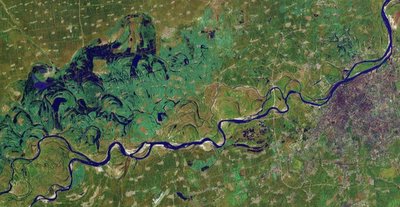The supertanker Exxon Mobil Valdez spilled between 11 million and 35 million gallons of crude oil. Take the middle value of 23 million gallons, assuming the density of crude oil to be 915 kg/m^3, this comes out to 915 * 42,000 = 38,430,000 kg of crude oil, or 38,430 tonnes. The Harbin benzene spill was 100 tonnes according to the BBC, which is 100,000 kg of benzene, less than 0.3% the Valdez spill by weight. Benzene is a lot more toxic however, and according to the BBC, this amount of benzene is "equivalent of 10 tanker-loads of lethal substances", all into the Songhua river. Tracing the BBC's reasoning, we note that 10 PANAMAX class tanker can carry up to 790,000 metric tons, hence the Harbin disaster spill is like a 20-super-tanker pile-up!. Ouch! I hope my math is wrong.
From the Wikipedia:
On March 23, 1989, the oil tanker Exxon Valdez departed from the Valdez oil terminal in Valdez, Alaska (on its 28th voyage), heading south through Prince William Sound, with a full load of oil. Captain Joseph Hazelwood radioed to the Coast Guard station that he would be changing course in order to avoid some growlers, small icebergs which had drifted into the sound from the Columbia Glacier... the vessel was not turning sharply enough and at 12:04 a.m. on March 24, the vessel hit Bligh Reef.
Hopefully the investigations into this disaster will yield a report as detailed and precise, to hold the responsible individuals accountable.
What about the people of Harbin?
In the NYT article The Half-Life of Anxiety on 7/10/2005 by Benedict Carey,
In studies of Alaskan communities that were affected by the oil spill from the tanker Exxon Valdez in 1989, and of towns dealing with water contamination in New Jersey and New York, sociologists have found what they call social corrosion. Sustained anxiety breaks down social groups and leads to an increase in mental health problems and potentially to economic downturn, said Lee Clarke, a sociology professor at Rutgers University and author of the forthcoming book, ''Worst Cases,'' an analysis of responses to disaster.
Much recent research analyzes mass disasters in terms of bioterrism, e.g., Facing the Possibility of Bioterrorism by Bill Durodi� in Current Opinion in Biotechnology:
In his [2004 book Therapy Culture: Cultivating Vulnerability in an Uncertain Age], Furedi explores the roots of a growing sense of social and individual vulnerability in what he coins 'therapeutic culture'. By increasingly framing problems through the prism of their emotions, people are actively incited to feel powerless and ill. Accordingly, �the spirit of stoicismand sacrifice�, along with �a sense of common purpose,unity or a commitment to fight� are now rarely in evidence. A powerful consequence of this, along with distorted perceptions and an increase in reported rates of depression, is provided by the phenomenon of mass psychogenic (or sociogenic) illness, numerous instances of which became evident in the aftermath of the anthrax attacks.
While the concept of "therapeutic culture" sounds reasonable and intriguing, it may be oversold here and takes on too much of a Theory of Everything tinge. I do like the basic idea though.
On an individual level,
- Dr. Jerome Groopman's take on The Grief Industry in the New Yorker (on Dr. Jeff Mitchell's 7 steps)
- A debate on psychological debriefing at British Journal of Psychiatry.
Technorati Tags:
China / Harbin /Benzene / Environment disaster





No comments:
Post a Comment